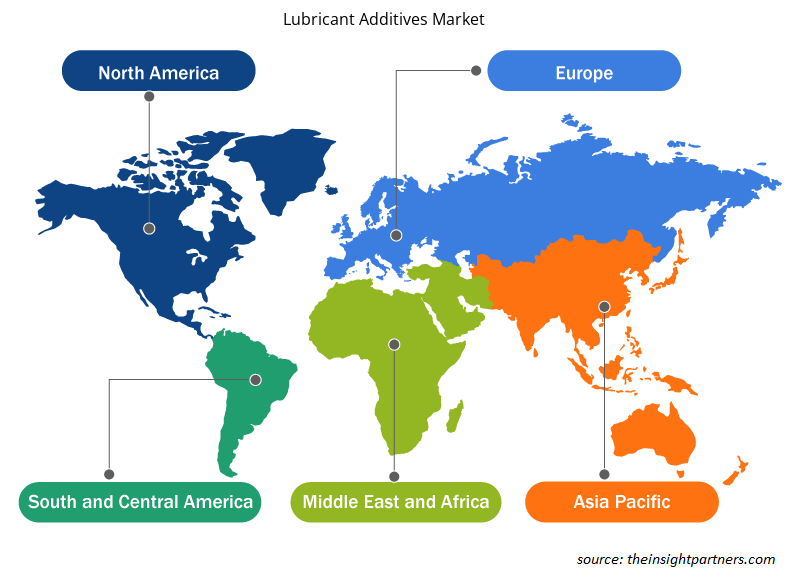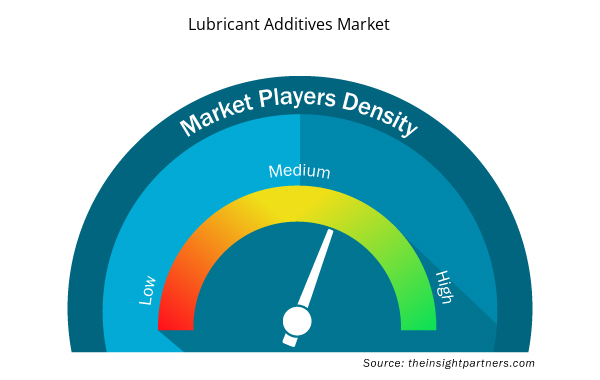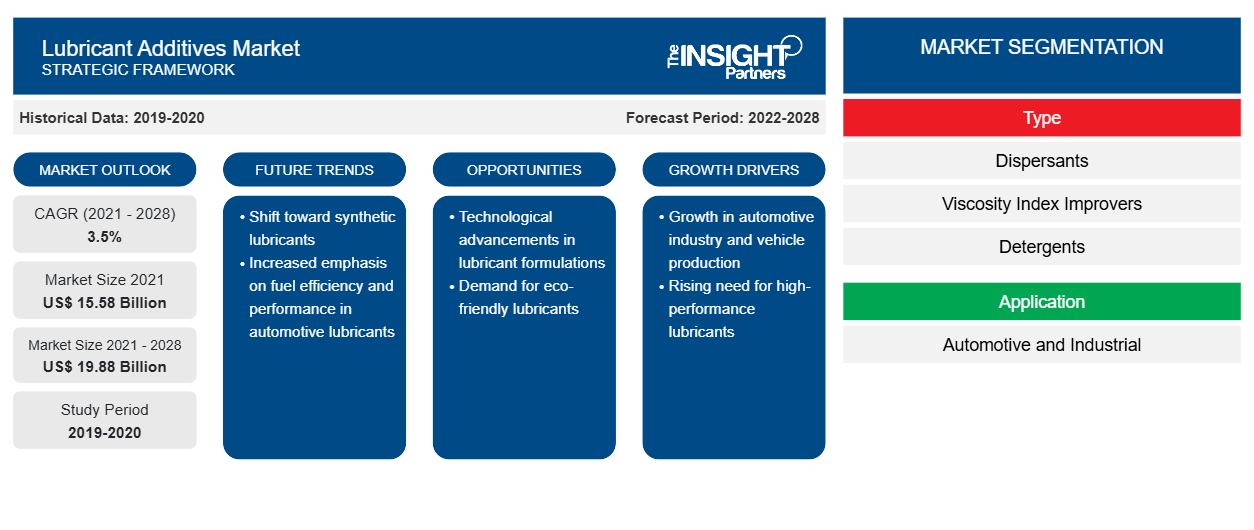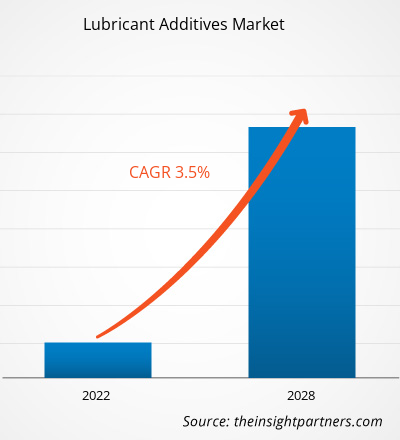El mercado de aditivos para lubricantes se valoró en US$ 15.584,9 millones en 2021 y se proyecta que alcance los US$ 19.880,12 millones en 2028; se espera que registre una CAGR del 3,5% de 2021 a 2028.
Los aditivos para lubricantes se utilizan en el procesamiento de lubricantes sintéticos, que se utilizan comúnmente en los sectores industrial y automotriz debido a sus características superiores a las del aceite mineral natural. Por lo tanto, el florecimiento de los sectores industrial y automotriz impulsa la demanda de lubricantes sintéticos. El aceite de motor es el lubricante más utilizado en los sectores automotriz e industrial. Tiene excelentes propiedades físicas y químicas, incluido un índice de viscosidad más alto, menor volatilidad, punto de fluidez y mayor estabilidad térmica. La adición de aditivos como modificadores de viscosidad y depresores del punto de fluidez en los lubricantes mejora sus propiedades físicas y químicas. Por lo tanto, la aplicación extensiva de lubricantes en varias industrias es el factor clave que impulsa el mercado de aditivos para lubricantes, ya que la mezcla de lubricantes con aditivos mejora su rendimiento y vida útil.
En 2020, Asia Pacífico tuvo la mayor participación del mercado mundial de aditivos para lubricantes . El principal factor que contribuye al crecimiento del mercado en esta región es la creciente demanda de aditivos para lubricantes de la industria automotriz y otras industrias manufactureras. El creciente desarrollo de piezas y componentes automotrices en la región con el aumento de la producción de vehículos, junto con las innovaciones continuas de los fabricantes de combustible para automóviles, crea oportunidades lucrativas para el mercado de lubricantes, lo que, a su vez, impulsa el crecimiento del mercado. Además, es probable que las crecientes actividades de construcción, especialmente en China e India, atraigan a los actores del mercado global para establecer sus negocios en Asia Pacífico. Los vehículos comerciales pesados se utilizan ampliamente en China, ya que los consumidores los prefieren debido a su alta capacidad de carga y fuertes sistemas de suspensión. Por lo tanto, son útiles en las actividades de transporte. Los vehículos comerciales pesados, por ejemplo, los camiones, se utilizan ampliamente en logística, construcción y agricultura debido a su gran capacidad de carga. Se utilizan principalmente para transportar escombros y materiales de un lugar a otro en cualquier terreno. Todos estos factores impulsarán la demanda del mercado de aditivos para lubricantes.
Personalice este informe según sus necesidades
Obtendrá personalización en cualquier informe, sin cargo, incluidas partes de este informe o análisis a nivel de país, paquete de datos de Excel, así como también grandes ofertas y descuentos para empresas emergentes y universidades.
- Obtenga las principales tendencias clave del mercado de este informe.Esta muestra GRATUITA incluirá análisis de datos, desde tendencias del mercado hasta estimaciones y pronósticos.
Impacto de la pandemia de COVID-19 en el mercado de aditivos para lubricantes
La pandemia de COVID-19 afectó gravemente al mercado mundial en 2020 debido a la interrupción de las cadenas de suministro de las materias primas utilizadas en la producción de aditivos para lubricantes. La flexibilización de las medidas de confinamiento en varios países y la reanudación de las actividades operativas en muchas industrias han contribuido a la reactivación de la demanda de aditivos para lubricantes a partir de 2021. Además, el rápido ritmo de los programas de vacunación contra la COVID-19 ha respaldado el crecimiento del mercado de aditivos para lubricantes.
Perspectivas del mercado
El rápido crecimiento industrial favorece el crecimiento del mercado de aditivos para lubricantes
Los lubricantes se encuentran entre los componentes clave utilizados en el sector industrial, ya que ayudan a que los equipos funcionen con alta eficiencia y máxima confiabilidad. Los lubricantes minerales y sintéticos, las grasas, los aceites para compresores y los fluidos de corte son varios tipos de lubricantes que se utilizan como aditivos en las industrias automotriz, de petróleo y gas, textil, vidrio, generación de energía, papel y pulpa, productos químicos y petroquímicos, agricultura, manufactura, alimentos y bebidas y farmacéutica, entre otras. El crecimiento de estas industrias en todo el mundo genera una gran demanda de lubricantes, así como de aditivos para lubricantes. Las industrias de acabado textil, especialmente en Asia Pacífico, generan una gran demanda de lubricantes industriales. Existe una gran demanda de lubricantes industriales de las industrias textiles en Asia Pacífico. Por lo tanto, la amplia aplicación de lubricantes en varias industrias y el rápido crecimiento del sector industrial son los factores clave que impulsan el mercado de aditivos para lubricantes.
Información sobre aplicaciones
Según la aplicación, el mercado se segmenta en automoción e industrial. El segmento de automoción tuvo una mayor participación de mercado en 2020. Los aditivos lubricantes se utilizan en el aceite de motor y el aceite de motor para evitar la floculación de sustancias inorgánicas en el aceite durante el funcionamiento. Existe una gran demanda de aditivos lubricantes en los aceites de motor multigrado, aceites para engranajes, fluidos de transmisión automática, fluidos de dirección asistida, grasas y algunos fluidos hidráulicos para mantener la viscosidad a altas temperaturas. Muchos fabricantes de automóviles están invirtiendo en la mejora de la eficiencia de combustible de los vehículos, lo que probablemente contribuirá aún más al crecimiento del mercado en los próximos años.
Algunos de los actores clave en el mercado de aditivos para lubricantes son Evonik Industries AG; The Lubrizol Corporation; LANXESS, Nouryon; Mol-lub Kft.; Dover Chemical Corporation; Croda International plc; Chevron Corporation; BASF SE; y EXXON MOBIL CORPORATION. Estas empresas ofrecen una amplia gama de carteras de productos para el mercado de aditivos para lubricantes. Estas empresas tienen presencia en las regiones en desarrollo, lo que brinda una oportunidad lucrativa para los aditivos para lubricantes. Estos actores del mercado están altamente enfocados en el desarrollo de productos innovadores y de alta calidad para satisfacer los requisitos del cliente.
Informe Destacado
- Tendencias progresivas de la industria en el mercado de aditivos para lubricantes para ayudar a los actores a desarrollar estrategias efectivas a largo plazo
- Estrategias de crecimiento empresarial adoptadas por los mercados desarrollados y en desarrollo
- Análisis cuantitativo del mercado de aditivos para lubricantes de 2019 a 2028
- Estimación de la demanda mundial de aditivos para lubricantes
- Análisis de las cinco fuerzas de Porter para ilustrar la eficacia de los compradores y proveedores en el mercado de aditivos para lubricantes
- Avances recientes para comprender el escenario competitivo del mercado
- Tendencias y perspectivas del mercado, así como factores que impulsan y restringen el crecimiento del mercado de aditivos para lubricantes
- Asistencia en el proceso de toma de decisiones destacando las estrategias de mercado que sustentan el interés comercial.
- El tamaño del mercado de aditivos para lubricantes en varios nodos
- Descripción detallada y segmentación del mercado, así como la dinámica de la industria de aditivos para lubricantes.
- Tamaño del mercado de aditivos para lubricantes en varias regiones con prometedoras oportunidades de crecimiento
Perspectivas regionales del mercado de aditivos para lubricantes
Los analistas de Insight Partners explicaron en detalle las tendencias y los factores regionales que influyen en el mercado de aditivos para lubricantes durante el período de pronóstico. Esta sección también analiza los segmentos y la geografía del mercado de aditivos para lubricantes en América del Norte, Europa, Asia Pacífico, Oriente Medio y África, y América del Sur y Central.

- Obtenga datos regionales específicos para el mercado de aditivos para lubricantes
Alcance del informe de mercado de aditivos para lubricantes
| Atributo del informe | Detalles |
|---|---|
| Tamaño del mercado en 2021 | US$ 15,58 mil millones |
| Tamaño del mercado en 2028 | US$ 19.88 mil millones |
| CAGR global (2021-2028) | 3,5% |
| Datos históricos | 2019-2020 |
| Período de pronóstico | 2022-2028 |
| Segmentos cubiertos | Por tipo
|
| Regiones y países cubiertos | América del norte
|
| Líderes del mercado y perfiles de empresas clave |
|
Densidad de actores del mercado: comprensión de su impacto en la dinámica empresarial
El mercado de aditivos para lubricantes está creciendo rápidamente, impulsado por la creciente demanda de los usuarios finales debido a factores como la evolución de las preferencias de los consumidores, los avances tecnológicos y una mayor conciencia de los beneficios del producto. A medida que aumenta la demanda, las empresas amplían sus ofertas, innovan para satisfacer las necesidades de los consumidores y aprovechan las tendencias emergentes, lo que impulsa aún más el crecimiento del mercado.
La densidad de actores del mercado se refiere a la distribución de las empresas o firmas que operan dentro de un mercado o industria en particular. Indica cuántos competidores (actores del mercado) están presentes en un espacio de mercado determinado en relación con su tamaño o valor total de mercado.
Las principales empresas que operan en el mercado de aditivos para lubricantes son:
- Industrias Evonik AG
- La Corporación Lubrizol
- LANXESS
- Nouryón
- Empresa Mol-Lub Kft.
Descargo de responsabilidad : Las empresas enumeradas anteriormente no están clasificadas en ningún orden particular.

- Obtenga una descripción general de los principales actores clave del mercado de aditivos para lubricantes
Mercado de aditivos para lubricantes
Tipo
- Dispersantes
- Mejoradores del índice de viscosidad
- Detergentes
- Agente antidesgaste
- Emulsionantes
- Otros
Solicitud
- Automotor
- Industrial
Perfiles de empresas
- Industrias Evonik AG
- La Corporación Lubrizol
- LANXESS
- Nouryón
- Empresa Mol-Lub Kft.
- Corporación química Dover
- Croda Internacional plc
- Corporación Chevron
- BASF SE
- CORPORACIÓN EXXON MOBIL
- Análisis histórico (2 años), año base, pronóstico (7 años) con CAGR
- Análisis PEST y FODA
- Tamaño del mercado Valor/volumen: global, regional, nacional
- Industria y panorama competitivo
- Conjunto de datos de Excel



Report Coverage
Revenue forecast, Company Analysis, Industry landscape, Growth factors, and Trends

Segment Covered
This text is related
to segments covered.

Regional Scope
North America, Europe, Asia Pacific, Middle East & Africa, South & Central America

Country Scope
This text is related
to country scope.
Preguntas frecuentes
Asia Pacific is estimated to register the fastest CAGR in the global lubricant additives market over the forecast period. The development of automotive parts and components in the region with the rise of electric vehicle production has created lucrative opportunities for lubricant additives. Extensive innovation and prototyping from major automakers coupled with consumer preference are some of the factors driving the market growth.
The industrial segment is estimated to register fastest CAGR in the global lubricant additives market. Lubricant is one of the key components used in the industrial sector, which helps keep the equipment operating at peak efficiency and with maximum reliability. There are numerous types of lubricants such as mineral and synthetic lubricants, greases, compressor oils, and cutting fluids that contain additives used across various industries, including automotive, oil & gas, textile, glass, power generation, paper & pulp, chemicals & petrochemicals, agriculture, manufacturing, food & beverages, and pharmaceuticals. The growth of these industries across the globe creates a huge demand for lubricants, this, in turn creates demand for lubricant additives.
The automotive segment held the largest share of the market in 2021. The automotive sector has witnessed tremendous growth in the last decade and is expected to rise steadily during the forecast period. As per the data of Organisation Internationale des Constructeurs d'Automobiles (OICA), the American countries recorded over ~16.2 million commercial & passenger car production in 2010, and this production rate has grown by more than 23% and registered over ~20 million commercial & passenger production in 2019. The automotive industry in China has been growing rapidly and the country is playing an increasingly important role in the global automotive market. With increasing regulatory pressure on improving the fuel efficiency of vehicles and reducing greenhouse gas emissions, there has been a remarkable development in lubricating oil formulations.
The dispersants segment held the largest market share. Dispersants are the highest volume additive used in crankcase lubricants and, with treat rates in heavy-duty vehicles and in passenger cars. Dispersants control sludge and varnish build-up by preventing the formation of large structures that could lead to gel formation, and by inhibiting their phase separation from the oil onto engine surfaces.
The major players operating in the global lubricant additives market are Evonik Industries AG; The Lubrizol Corporation; LANXESS, Nouryon; Mol-lub Kft.; Dover Chemical Corporation; Croda International plc; Chevron Corporation; BASF SE; and EXXON MOBIL CORPORATION
In 2021, Asia Pacific held the largest share of the global lubricant additives market. The rise in the number of on-fleet vehicles in countries like China, India and South Korea has fueled the demand for lubricant additives. Increasing awareness regarding fuel economy will propel the demand for lubricant additives in the Asia Pacific.
Trends and growth analysis reports related to Chemicals and Materials : READ MORE..
The List of Companies - Lubricant Additives Market
- Evonik Industries AG
- The Lubrizol Corporation
- LANXESS
- Nouryon
- Mol-lub Kft.
- Dover Chemical Corporation
- Croda International plc
- Chevron Corporation
- BASF SE
- EXXON MOBIL CORPORATION
The Insight Partners performs research in 4 major stages: Data Collection & Secondary Research, Primary Research, Data Analysis and Data Triangulation & Final Review.
- Data Collection and Secondary Research:
As a market research and consulting firm operating from a decade, we have published and advised several client across the globe. First step for any study will start with an assessment of currently available data and insights from existing reports. Further, historical and current market information is collected from Investor Presentations, Annual Reports, SEC Filings, etc., and other information related to company’s performance and market positioning are gathered from Paid Databases (Factiva, Hoovers, and Reuters) and various other publications available in public domain.
Several associations trade associates, technical forums, institutes, societies and organization are accessed to gain technical as well as market related insights through their publications such as research papers, blogs and press releases related to the studies are referred to get cues about the market. Further, white papers, journals, magazines, and other news articles published in last 3 years are scrutinized and analyzed to understand the current market trends.
- Primary Research:
The primarily interview analysis comprise of data obtained from industry participants interview and answers to survey questions gathered by in-house primary team.
For primary research, interviews are conducted with industry experts/CEOs/Marketing Managers/VPs/Subject Matter Experts from both demand and supply side to get a 360-degree view of the market. The primary team conducts several interviews based on the complexity of the markets to understand the various market trends and dynamics which makes research more credible and precise.
A typical research interview fulfils the following functions:
- Provides first-hand information on the market size, market trends, growth trends, competitive landscape, and outlook
- Validates and strengthens in-house secondary research findings
- Develops the analysis team’s expertise and market understanding
Primary research involves email interactions and telephone interviews for each market, category, segment, and sub-segment across geographies. The participants who typically take part in such a process include, but are not limited to:
- Industry participants: VPs, business development managers, market intelligence managers and national sales managers
- Outside experts: Valuation experts, research analysts and key opinion leaders specializing in the electronics and semiconductor industry.
Below is the breakup of our primary respondents by company, designation, and region:

Once we receive the confirmation from primary research sources or primary respondents, we finalize the base year market estimation and forecast the data as per the macroeconomic and microeconomic factors assessed during data collection.
- Data Analysis:
Once data is validated through both secondary as well as primary respondents, we finalize the market estimations by hypothesis formulation and factor analysis at regional and country level.
- Macro-Economic Factor Analysis:
We analyse macroeconomic indicators such the gross domestic product (GDP), increase in the demand for goods and services across industries, technological advancement, regional economic growth, governmental policies, the influence of COVID-19, PEST analysis, and other aspects. This analysis aids in setting benchmarks for various nations/regions and approximating market splits. Additionally, the general trend of the aforementioned components aid in determining the market's development possibilities.
- Country Level Data:
Various factors that are especially aligned to the country are taken into account to determine the market size for a certain area and country, including the presence of vendors, such as headquarters and offices, the country's GDP, demand patterns, and industry growth. To comprehend the market dynamics for the nation, a number of growth variables, inhibitors, application areas, and current market trends are researched. The aforementioned elements aid in determining the country's overall market's growth potential.
- Company Profile:
The “Table of Contents” is formulated by listing and analyzing more than 25 - 30 companies operating in the market ecosystem across geographies. However, we profile only 10 companies as a standard practice in our syndicate reports. These 10 companies comprise leading, emerging, and regional players. Nonetheless, our analysis is not restricted to the 10 listed companies, we also analyze other companies present in the market to develop a holistic view and understand the prevailing trends. The “Company Profiles” section in the report covers key facts, business description, products & services, financial information, SWOT analysis, and key developments. The financial information presented is extracted from the annual reports and official documents of the publicly listed companies. Upon collecting the information for the sections of respective companies, we verify them via various primary sources and then compile the data in respective company profiles. The company level information helps us in deriving the base number as well as in forecasting the market size.
- Developing Base Number:
Aggregation of sales statistics (2020-2022) and macro-economic factor, and other secondary and primary research insights are utilized to arrive at base number and related market shares for 2022. The data gaps are identified in this step and relevant market data is analyzed, collected from paid primary interviews or databases. On finalizing the base year market size, forecasts are developed on the basis of macro-economic, industry and market growth factors and company level analysis.
- Data Triangulation and Final Review:
The market findings and base year market size calculations are validated from supply as well as demand side. Demand side validations are based on macro-economic factor analysis and benchmarks for respective regions and countries. In case of supply side validations, revenues of major companies are estimated (in case not available) based on industry benchmark, approximate number of employees, product portfolio, and primary interviews revenues are gathered. Further revenue from target product/service segment is assessed to avoid overshooting of market statistics. In case of heavy deviations between supply and demand side values, all thes steps are repeated to achieve synchronization.
We follow an iterative model, wherein we share our research findings with Subject Matter Experts (SME’s) and Key Opinion Leaders (KOLs) until consensus view of the market is not formulated – this model negates any drastic deviation in the opinions of experts. Only validated and universally acceptable research findings are quoted in our reports.
We have important check points that we use to validate our research findings – which we call – data triangulation, where we validate the information, we generate from secondary sources with primary interviews and then we re-validate with our internal data bases and Subject matter experts. This comprehensive model enables us to deliver high quality, reliable data in shortest possible time.


 Obtenga una muestra gratuita de este informe
Obtenga una muestra gratuita de este informe